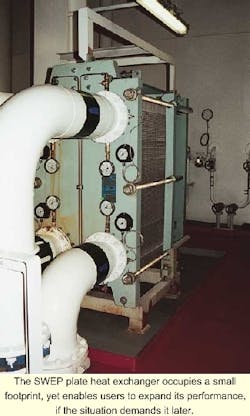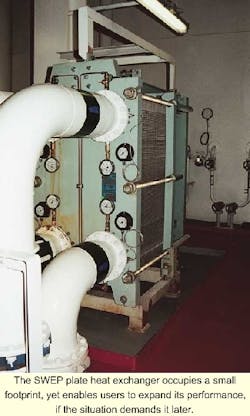PLATE HEAT EXCHANGERS: Asymmetric design optimizes heat transfer, limits pressure loss
Plate heat exchanger specialist SWEP International PHE has recently de livered two of its GX140 heat exchangers to support Unocal's Pailin Phase 2 project offshore Thailand. The high specification heat exchangers feature titanium plates of 1.4 sq meters and will be used for crude oil cooling at the wellhead. Each complete unit is 4 meters long by 3 meters high and 0.8 meters wide, and has the capacity to cool up to 5,000 bbl/hr of crude by up to 100° C. The nature of the SWEP design also gives Unocal the option of changing the throughput or performance characteristics of its heat exchangers, if field conditions change later.
Stockholm-based SWEP claims 25% of the world market for marine heat exchangers and Product Manager Torbjörn Lantz believes that the benefits enjoyed by ship operators will prove increasingly valuable offshore. "The asymmetrical plate used in our Ultraflex system is the SWEP speciality," he says. "It permits better area usage and 10% better performance, as you can create six different channels for each changer. Besides operating more effectively, this arrangement requires less area, thus makes it cheaper. SWEP's intelligent exchanger geometry, gives an outstanding relationship between pressure drop and U-values. This results in optimal heat transfer and minimal pressure waste."
Each plate heat exchanger manufactured by SWEP, or its sister company Tranter in the United States, consists of a frame that holds a combination of numerous thin embossed metal plates tightly together. The plates are typically pressed in stainless steel but can also be made from titanium or nickel alloys. The design incorporates high performance gaskets that enable the plates to be assembled in the frame to create alternating channels for the hot and cold mediums flowing between them.
Herringbone pattern
SWEP has patented a range of carefully designed herringbone patterns that are stamped into each plate. When stacked together with alternate plates turned 180°, the patterns interact and form channels for a turbulent flow of media with maximum heat transfer capabilities. The high level of turbulence also minimizes the fouling and wax build-up that can occur when processing liquids such as crude oil. When such buildup is anticipated at the design stage, it is possible to employ a plate configuration that also keeps it to a minimum.
If the operating re quirements of the field change later, it is a simple operation to add more plates in situ to increase the exchanger's output or to alter the characteristics of the heat exchange process.
The heat exchangers can withstand a maximum pressure of 25 bar and a top temperature of 180° C. For applications involving higher pressures, Torbjörn Lantz recommends the use of semi-welded or welded plate over a conventional shell and tube heat exchanger, since the latter typically occupies an 80% larger footprint and can be 25 % more expensive. Lantz points out that this price differential can be even greater if titanium components are required.
Asymmetrical flow
Many heat exchanger applications demand an asymmetrical flow whereby the volumes of the two flows through the exchanger are different. This provides two thermal lengths - one for the hot side, the other for the cold. SWEP designers maintain that the difficulty of providing this capability in other heat exchanger designs can result in expensive, over-sized units. SWEP has overcome this problem through its versatile plate designs, which make it possible to achieve asymmetrical flows and full turbulence in each with co-current or counter-current flows. This has the additional advantage of creating a higher capacity with less plate surface resulting in a smaller heat exchanger for a given performance rating.
A pair of high-theta plates will give high heat transfer and comparatively high pressure drop. A pair of low-theta plates does the opposite. One of each gives a medium-theta effect. By combining different pairs in a plate pack, users are able to gain complete control of the flow rate and the pressure drop. By choosing the most appropriate pattern and plate combination, SWEP maintains that users can operate a heat exchanger that exactly meets their requirements.
For more information contact Torbjörn Lantz, SWEP. Tel: +46 8 442 49 76, Fax: +46 8 442 49 80, Email: [email protected].

